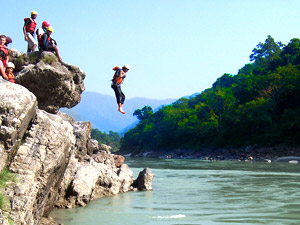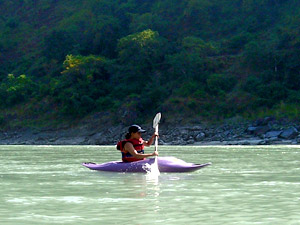White Water Rafting and Kayaking
Rafting or whitewater rafting is a challenging recreational activity using an inflatable raft to navigate a river or other bodies of water. This is usually done on whitewater or different degrees of rough water, in order to thrill and excite the raft passengers. The development of this activity as a leisure sport has become popular since the mid-1970s.
We arrange adventure tour package for various basic and advanced courses for 6 and 10 days respectively. Our campsite is situated in Rishikesh on the banks of Huyel river for adventure river rafting. Our campsite courses are for 3 to 15 days and include whitewater rafting, adventure trekking, river rafting, river crossing and rock climbing.

What do we offer?
We organize different activities through the whole Himalayas. On demand we can offer other programs and everything is of course tailor made.
- Accommodation and meals in a safari tent in a beach camp by the river
- Rafting
- Barbeque snacks and Soft beverages over the campfire
- Kayaking
- Evening bonfire
- Beach games - beach volleyball, beach cricket, rugby
Rafting in river Beas
White water rafting in Kullu valley is done on river Beas from Pirdi (4 kms ahead of Kullu town) down to Jhiri, a stretch of approximately 14 kms. The journey takes nearly one & half hour consisting of rapids from grade II & III.
A certified guide is provided along with camping at river side which includes stay in tented accomodation, veg. food and river raft.
Rafting in river Sutlej
The Satluj river basin in Himachal Pradesh covers an area of about 6,553 square kilometers. To the east lies the Ngari region of Tibet; the Dhauladhar range forms its southern boundary, separating it from Uttarkashi District of Uttar Pradesh and the Shimla District of Himachal Pradesh. In the west, the Srikhand Dhar marks the boundary between Kinnaur and Kulu. Spiti is on the northern border of Kinnaur -- the boundary being formed by the rivers Spiti and Pare Chu near the Indo-Tibetan border.
The source of the Satluj lies in near the Mansarovar Lake at 18500 ft. in the Tibetan Plateau. The Satluj is one of only three Trans Himalayan rivers originating in the high Tibetan Plateau that cuts across the mighty Himalayan ranges. The other two are the Indus and the Brahmaputra. It enters India through a fearsome gorge near the Shipki La. Thereafter, it flows through the cold tracts of Kinnaur to the hamlet of Wangtoo. It is one of the major tributaries of the Indus River system. In its passage across Kinnaur, the Satluj River successively crosses three great mountain ranges -- the Zanskar range, the Great Himalayan range and the Dhauladhar range. To the east of the Satluj the valleys are narrow while in the west, they are wide and open. Many tributaries join the main Satluj River one after the other from the south. The Baspa is one of the major tributaries of the Satluj. The valley of the Satluj extends on both flanks of the Satluj River - from where it enters Kinnaur to the place where it makes its exit. It is the largest valley of Kinnaur, extending in a northeast to southwest alignment for a length of about 140-km along the Satluj River. The northeastern part of this valley is drier and conditions become humid towards the southwest. The Satluj River has carved a deep gorge across the main or Great Himalaya near Pshong- Tong. In the southern part of this valley, there is extensive cultivation of fruits and agricultural crops. Barring some parts, extensive vineyards, thriving crops and orchards of apricot, apples and grapes are to be found in the entire region
Trans Himalayan rivers originating in the high Tibetan Plateau that cuts across the mighty Himalayan ranges. The other two are the Indus and the Brahmaputra. It enters India through a fearsome gorge near the Shipki La. Thereafter, it flows through the cold tracts of Kinnaur to the hamlet of Wangtoo. It is one of the major tributaries of the Indus River system. In its passage across Kinnaur, the Satluj River successively crosses three great mountain ranges -- the Zanskar range, the Great Himalayan range and the Dhauladhar range. To the east of the Satluj the valleys are narrow while in the west, they are wide and open. Many tributaries join the main Satluj River one after the other from the south. The Baspa is one of the major tributaries of the Satluj. The valley of the Satluj extends on both flanks of the Satluj River - from where it enters Kinnaur to the place where it makes its exit. It is the largest valley of Kinnaur, extending in a northeast to southwest alignment for a length of about 140-km along the Satluj River. The northeastern part of this valley is drier and conditions become humid towards the southwest. The Satluj River has carved a deep gorge across the main or Great Himalaya near Pshong- Tong. In the southern part of this valley, there is extensive cultivation of fruits and agricultural crops. Barring some parts, extensive vineyards, thriving crops and orchards of apricot, apples and grapes are to be found in the entire region




